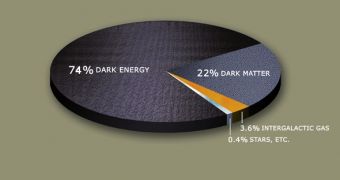Dark energy is a hypothesized force in the Universe that is believed to be largely responsible for the ever-accelerating speed at which the Cosmos expands. This was inferred from the fact that galaxies appeared to be moving away from each other, which is consistent with a scenario in which the entire cosmic bubble is expanding. The only sources for dark energy ideas and hypotheses were space studies until now, but physicists believe they may have finally found a way of detecting it inside the controlled confines of scientific laboratories.
According to advanced calculations, this energy fills the surrounding space at a density of about 10^-10 joules per cubic meter. But the thing that makes the dark energy theory very bizarre, and also a bit out of tune with the laws of physics is that the basic rule that states that, in any system, energy is conserved, is not respected. In order for the theory to hold, an increased volume of space needs to be driven by an increased amount of energy. But there is no apparent source or balance for this energy, so the rule of energy conservation is bypassed. This is not something physicists do gladly.
Just recently, experts Holger Mueller, from the University of California in Berkeley (UCB), and Martin Perl, from the Stanford University, proposed a new way of moving the study of dark matter out of space, and into the scientific lab. The two argue that we have the technological capabilities to measure such low energies as that of the dark variety. An electric field of one volt, they say, produces an energy density of just 10^-12 joules per cubic meter, which is lower than the proposed density of dark energy.
The problem, they explain, lies within the fact that the stuff they are trying to study cannot be turned off. Additionally, they say, there is no frame of reference to compare densities to, so these are some of the first things researchers need to start working on. Still, the group says, there is the distinct possibility that a gradient may be identified within dark energy. If so, all that experts have to do, at least in theory, would be to screen out other electromagnetic forces using conventional shields, and to scan for the gradient using atom interferometry.
Two atom interferometers could then be used to cancel out gravitational forces, they add. This type of experiments is already possible, as experts have successfully measured the gravitational pull of our planet to an accuracy of 10^-9, using a single atom interferometer. By employing two, the accuracy could be vastly increased, to at least 10^-17. Further details of this work appear in the latest issue of the online journal arXiv.

 14 DAY TRIAL //
14 DAY TRIAL //